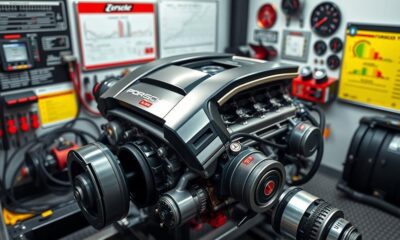Ford Tuning
Ford Fiesta Tuning: Unlock the Full Potential of Your Subcompact
Maximize your Ford Fiesta’s performance with expert tuning tips that could transform your driving experience; discover the secrets to unleashing its full potential.

Tuning your Ford Fiesta can really reveal its true potential. By remapping the ECU, you can gain an impressive 10-15 BHP and boost torque considerably. Adding an upgraded air intake or exhaust system can further enhance performance, pushing you close to 137 hp. Plus, reducing weight can improve handling and acceleration. While some modifications may strain your budget, others, like simple weight reductions, are cost-effective. Just remember, tuning is about balance; you want to enhance performance without sacrificing comfort. Interested in how to navigate the options available? You'll want to explore more about the best tuning strategies.
Key Takeaways
- Engine tuning can boost Ford Fiesta's power by 10-15 BHP and torque by 10-25 Nm, maximizing performance potential.
- Upgrading components like air intake kits and exhaust systems can yield significant horsepower gains at relatively low costs.
- Weight reduction enhances power-to-weight ratios, improving acceleration and handling without extensive financial investment.
- Community resources, such as forums and clubs, offer valuable insights and support for tuning enthusiasts.
- Consider balancing comfort with performance to ensure a satisfying driving experience while tuning your Ford Fiesta.
Performance Modifications Overview
When it comes to enhancing your Ford Fiesta's performance, a variety of modifications can make a noticeable difference. Performance modifications like air intake kits, exhaust systems, and engine tuning can greatly boost your ride.
For instance, upgrading your exhaust can yield about 10 hp, while cold air intake mods can add another 5 hp. If you combine these with headers, you'll see even more power, especially at higher RPMs.
Don't overlook weight reduction techniques. By removing back seats or using lightweight racing components, every 21.5 lbs you shed can translate to roughly a 1 hp increase.
Engine tuning is another critical area; remapping and off-the-shelf tunes can provide gains of 10-15 BHP and improve throttle response, particularly when matched with supporting modifications.
You can explore popular tuning brands like Cobb Tuning or Dizzy Tuning, which offer tailored solutions to optimize your Fiesta's performance based on your specific upgrades and fuel type.
With the right performance modifications, you'll not only feel the difference in power but also enjoy a more responsive driving experience.
Cost Vs. Performance Trade-Offs

When tuning your Ford Fiesta, it's essential to weigh the financial investment against the performance gains you expect.
Some modifications can cost thousands but may not drastically improve your driving experience, while others might offer better value at a lower price.
You'll need to evaluate what enhancements are worth the expense and how they align with your overall goals for the vehicle.
Financial Investment Considerations
Investing in performance upgrades for your Ford Fiesta can lead to notable improvements, but it often comes with hefty price tags. When considering financial investment considerations, you need to weigh the costs against the performance enhancements you desire.
Here's a quick breakdown of some common upgrades:
| Upgrade Type | Approximate Cost | Performance Gain |
|---|---|---|
| Turbo/Supercharger | $3,000+ | Significant boost |
| Nitrous Kits | $500 – $1,000 | Quick horsepower spike |
| Weight Reduction (21.5 lbs) | Minimal (DIY) | ~1 hp increase |
While turbo or supercharger installations can substantially elevate your Fiesta's performance, they can exceed $3,000 and impact your vehicle's value. On the other hand, nitrous kits are more budget-friendly but carry risks, including potential engine damage.
Moreover, some modifications may void your vehicle's warranty, so consider this aspect carefully. Finally, always assess the balance between comfort and performance; some upgrades might compromise daily drivability. Make sure you're ready for the financial implications of your tuning journey!
Performance Improvement Expectations
Understanding the financial implications of performance upgrades for your Ford Fiesta sets the stage for evaluating what you can realistically expect regarding improvements.
While performance enhancements can yield significant power gains, it's vital to weigh the cost versus the benefits. For instance, installing a turbo or supercharger can exceed $3,000, potentially impacting your vehicle's trade-in value.
On the other hand, modifications like cold air intakes and exhaust systems may provide noticeable boosts in performance but generally result in only 5-10 hp increases.
Engine tuning is essential after any modifications to maximize horsepower and torque, but keep in mind that it may require additional supporting mods, adding to your overall investment.
If you're looking for a more budget-friendly approach, consider weight reduction strategies.
Removing back seats or using lightweight components can lead to about 1 hp gained for every 21.5 lbs removed, offering a cost-effective way to improve performance without breaking the bank.
Just remember, while these enhancements can elevate your Fiesta's dynamics, they might also compromise ride quality, so consider your driving preferences carefully before diving into upgrades.
Engine Specifications and Comparisons
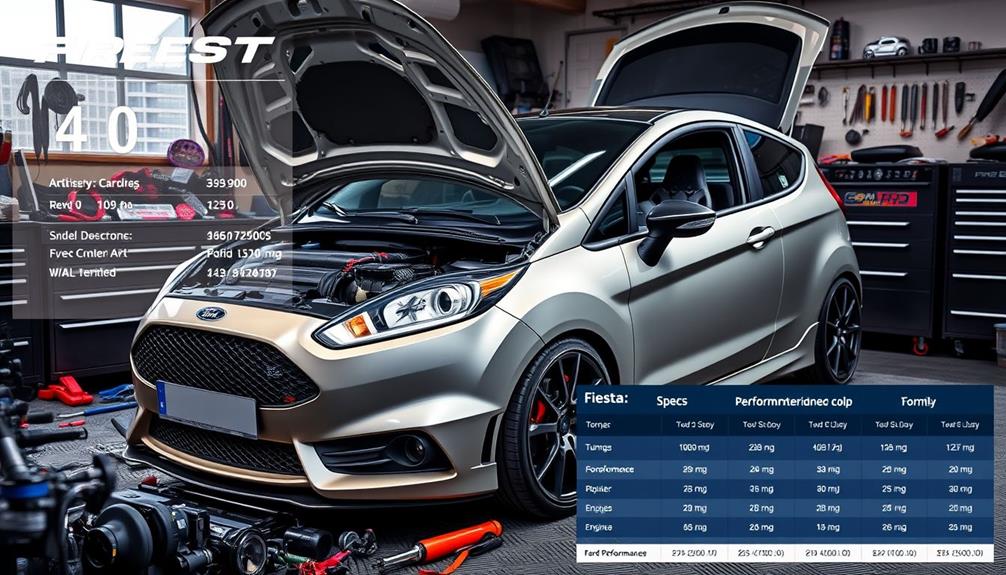
When you look at the Ford Fiesta's 1.6L engine, you'll notice it produces 120 hp, but how does it stack up against historical models like the 1986 Omni GLH?
Comparing performance metrics like 0-60 mph times and power-to-weight ratios can really highlight the advancements in engine efficiency over the years.
Understanding these specs will help you make informed tuning decisions for your Fiesta.
Engine Performance Metrics
The Ford Fiesta's engine performance metrics reveal a balance of power and efficiency that appeals to enthusiasts and everyday drivers alike. With its 1.6L engine producing 120 hp, it achieves a respectable 0-60 mph time of about 9.5-10 seconds and a top speed of 118 mph.
The stock Fiesta boasts a power-to-weight ratio of 21.5, offering a solid foundation for performance upgrades. You can access even more potential through weight reduction strategies, like removing unnecessary interior components.
For power enthusiasts, modifications like cold air intakes can add approximately 5 hp. However, to truly maximize your Fiesta's performance, consider a combination of enhancements. Upgrading exhaust systems and utilizing proper tuning methods, such as Dyno Tunes, can yield significant gains.
If you're driving the 125 hp version of the Fiesta MK7, remapping the ECU can push power output up to 134 hp with the right supporting modifications. Overall, these performance metrics highlight the Fiesta's capability and versatility, making it a prime candidate for tuning and upgrades that enhance both power and driving experience.
Historical Engine Comparisons
Throughout automotive history, engine specifications have evolved markedly, showcasing advancements in both power output and efficiency.
Take the 2011 Ford Fiesta, which boasts a 1.6L engine producing 120 hp, achieving a 0-60 mph time of 9.5-10 seconds. In comparison, the 1986 Omni GLH, with similar displacement, managed 0-60 in just 8.5 seconds at a top speed of 110 mph.
As seen in various sectors, such as investment strategies, understanding historical performance can provide valuable insights for future enhancements, especially when considering investment options.
Here are some key insights into historical engine comparisons:
- The 1958 MG-A Twin Cam delivered 108 hp from a 1.6L engine, emphasizing early efficiency.
- The Fiesta's stock power-to-weight ratio is 21.5, highlighting the role of weight reduction.
- Modifications on the Fiesta, like a cold air intake, can increase power by around 5 hp.
- Historical engines often showed limited performance gains from single modifications without thorough upgrades.
- Modern engines face more restrictions, yet the Fiesta still displays impressive efficiency and power metrics.
These comparisons reflect how advancements in technology have fundamentally changed how we view engine performance, emphasizing the importance of both power and weight in achieving ideal results.
Power-to-Weight Ratios
Understanding power-to-weight ratios is essential for evaluating a vehicle's performance. For the Ford Fiesta, the stock ratio is approximately 21.5 lbs/hp, with a weight of 2,575 lbs and a 1.6L engine producing 120 hp. By removing 150 lbs, you can greatly improve this ratio, making the Fiesta feel like it has 137 hp.
Here's a comparison table to illustrate the impact of power-to-weight ratios:
| Vehicle | Weight (lbs) | Horsepower | Power-to-Weight Ratio (lbs/hp) |
|---|---|---|---|
| Ford Fiesta (Stock) | 2,575 | 120 | 21.5 |
| Ford Fiesta (Modified) | 2,425 | 137 | 17.7 |
| 1986 Omni GLH | 2,500 | 100 | 25 |
| 1958 MG-A Twin Cam | 2,200 | 108 | 20.4 |
As you can see, an increase in power or a reduction in weight directly enhances performance metrics. Modifying your Fiesta's engine, like adding a cold air intake for an increase in power, can lead to even better performance, making it a more thrilling ride.
Realistic Performance Expectations

While you might dream of transforming your Ford Fiesta into a high-performance machine, it's crucial to keep realistic expectations in mind. The stock Fiesta typically clocks a 0-60 mph time of around 9.5-10 seconds, which is standard for subcompact cars.
Here's what you can expect when tuning your Fiesta and adding supporting mods:
- Individual mods like cold air intakes or exhaust systems often yield a modest 5-10 hp boost.
- Combining multiple modifications can lead to more noticeable gains, potentially raising a 125 hp Fiesta MK7 to around 134 hp.
- Reducing weight can greatly enhance performance; shedding 150 lbs can feel like adding 10-15 hp.
- While tuning improves throttle response, the overall driving experience remains limited compared to sportier vehicles.
- Comfort should also be a consideration; not every performance mod enhances ride quality.
Community Resources and Support

Tuning your Ford Fiesta can be an exciting journey, and connecting with fellow enthusiasts can make all the difference. Online forums like the Fiesta Faction, with over 248,600 posts and 12,800 members, offer a treasure trove of information on performance kits and modifications.
You'll find valuable insights into troubleshooting and the latest trends in tuning your subcompact.
The Ford Owners Club is another great platform, fostering community engagement through shared experiences. Here, members discuss their tuning adventures, recommend performance kits, and provide tips for keeping modifications simple and cost-effective.
Personal anecdotes shared by fellow owners can help you navigate your tuning journey more smoothly.
Additionally, online resources like Amazon and various automotive websites assist you in finding performance parts while reading honest product reviews from experienced users.
By participating in polls and providing feedback in forums, you can gain insights into popular modifications and preferences, ensuring you make informed choices.
With these community resources and support, you'll feel empowered to release your Fiesta's full potential while enjoying the camaraderie of fellow enthusiasts.
Tuning Solutions for Enhanced Power

Boosting your Ford Fiesta's power can be achieved through a variety of tuning solutions that deliver impressive results. If you’re looking to increase the performance of your Ford Fiesta, you can consider options such as ECU remapping, installing a performance air intake, and upgrading the exhaust system. These modifications can help optimize fuel and air flow, leading to increased horsepower and torque.
When it comes to tuning your Toyota Yaris, similar modifications can be made to enhance its power and performance. ECU remapping, intake and exhaust upgrades, and even turbocharging or supercharging are all popular options for boosting power in the Yaris. With the right tuning solutions, you can unlock the full potential of your Yaris and enjoy a more exhilarating driving experience.
Whether you want to increase horsepower or improve overall driving dynamics, there are several options to evaluate.
Here are some effective tuning solutions:
- Engine Tuning: Gain 10-15 BHP and 10-25 Nm of torque, especially when paired with intake and exhaust modifications.
- Off-the-Shelf Maps: These can provide about 70% effectiveness in performance gains, making them a quick and cost-effective option.
- Pro Tunes: For those seeking maximum performance, pro tunes can approach 99% effectiveness, ensuring you access your Fiesta's full potential.
- Cobb Accessport V3: This tool allows you to tune using instant changes to calibration tables, enhancing throttle response and adding features like launch control.
- Mountune MP140 Upgrade: This option boosts your 125 HP Fiesta MK7 to 134 HP while maintaining reliability with factory hardware.
Customer Feedback and Experiences

Owners of Ford Fiestas often share their experiences after tuning, highlighting the tangible benefits they've enjoyed. Many report significant performance boosts of 10-15 BHP, which translates into noticeable increases in power and torque.
You'll likely appreciate the enhanced throttle response that comes with engine remapping, making your driving experience more engaging.
After installing aftermarket intercoolers alongside tuning modifications, users frequently mention smoother acceleration and reduced engine knock. If you're considering a Cobb Accessport V3, you might find its adjustable traction control and launch control features immensely helpful, as they improve driving dynamics, especially in your Fiesta ST.
Community feedback suggests that even with fewer modifications, you can achieve greater power gains by optimizing your current setup before diving into extensive upgrades. This insight can save you both time and money while maximizing your vehicle's potential.
Many customers commend the cost-effectiveness of tuning options, like the Dizzy Tuning Stage 1 Flash Tune, which delivers noticeable performance improvements without breaking the bank.
Related Tuning Case Studies

When considering tuning options for your Ford Fiesta, examining real-world case studies can provide invaluable insights.
You'll find that many enthusiasts have achieved impressive performance gains, transforming their vehicles into spirited machines.
Here are some key takeaways from various tuning experiences:
- ECU Remapping: Boosts power by 10-15 BHP and torque by 10-25 Nm, especially when paired with an upgraded exhaust system.
- Mountune MP140 Upgrade: Elevates the stock 125 HP Fiesta MK7 to 134 HP through optimized software and hardware tweaks.
- Aftermarket Intercoolers: These greatly lower engine temperatures, reducing knock issues, and enhancing reliability during spirited driving.
- OTS Tuning Options: Many users report substantial improvements in throttle response and overall driving dynamics.
- Power-to-Weight Ratio: Combining tuning, weight reduction, and quality tires can dramatically enhance handling characteristics.
Frequently Asked Questions
How to Make a Ford Fiesta More Powerful?
To make your car more powerful, consider installing a cold air intake, upgrading the exhaust system, tuning the engine, reducing weight, or adding a turbocharger. Each modification enhances performance and responsiveness considerably. Enjoy the upgrades!
Can You Tune a Ford Fiesta?
Imagine feeling your heart race as you hit the gas. Yes, you can tune your Ford Fiesta! With options like engine remapping and aftermarket upgrades, you'll experience improved performance, throttle response, and acceleration.
How Do I Unlock My Ford Fiesta?
To open your Ford Fiesta, consider engine remapping, upgrading intake and exhaust systems, and using tools like Cobb Accessport V3. Engage with online communities for tips and guarantee you're using the right fuel for peak performance.
How Do You Reset the ECU on a Ford Fiesta?
To reset your ECU, think of it as giving your car a fresh start. Disconnect the negative battery terminal for 15 minutes, reconnect, then turn the ignition on without starting. Drive a bit to let it recalibrate.
Conclusion
So, you've got a Ford Fiesta, and you're convinced it's just a cute little subcompact, right? Well, think again! With the right tuning, you can transform that unassuming ride into a powerhouse that leaves other cars in the dust. It's almost ironic how a car designed for practicality can morph into a performance beast with a few tweaks. So, why settle for mundane when you can release the thrill? Immerse yourself in tuning and let your Fiesta surprise you! If you’re ready to take your Ford Fiesta to the next level, consider investing in the best Porsche tuning upgrades. These upgrades can enhance the engine performance, suspension, and overall handling of your Fiesta, making it feel like a whole new car. With the right tuning upgrades, you’ll be able to unleash the full potential of your Fiesta and stand out on the road like never before.
Alex is our go-to expert on performance tuning, with over a decade of experience in the automotive industry. His deep understanding of engine dynamics, exhaust systems, and performance software allows him to break down complex concepts into easy-to-follow guides. Whether you’re looking to boost horsepower or fine-tune your vehicle’s responsiveness, Alex’s insights will help you achieve peak performance.
Ford Tuning
Ford Edge 2011 Tuning: Transforming Your Crossover Into a Performance Beast
You won’t believe how simple upgrades can unleash your 2011 Ford Edge’s hidden power—discover the secrets to transforming your crossover today!

Tuning your 2011 Ford Edge can turn it into a performance beast. Start with simple modifications like a Cold Air Intake and a Magna Flow exhaust to enhance efficiency and power. You'll see modest horsepower gains, with peak outputs hitting around 221.7 HP at the wheels after dyno testing. Understanding drivetrain losses, especially in all-wheel-drive systems, is key to maximizing your upgrades. As you tweak your vehicle, real-world performance will improve over time. Plus, joining the Ford Edge community offers valuable insights and support. Keep exploring, and you'll uncover even more tuning tips and tricks!
Key Takeaways
- Upgrading to a Cold Air Intake (CAI) and Magna Flow exhaust can slightly boost horsepower and enhance engine efficiency in the Ford Edge 2011.
- Regular dyno testing helps establish performance benchmarks and track improvements post-tuning, revealing true horsepower gains after modifications.
- Understanding drivetrain losses is essential; AWD configurations can experience up to 28% reduction in power delivered to the wheels.
- Installing a Pedal Commander optimizes throttle response, allowing for a more engaging driving experience with various driving modes.
- Engaging with the Ford Edge community fosters knowledge sharing on effective tuning practices and real-world performance outcomes.
Understanding Performance Modifications
When tuning your 2011 Ford Edge Sport, it's crucial to understand how performance modifications can impact your vehicle's efficiency and power. Upgrades like a cold air intake (CAI) and a Magna Flow exhaust are popular choices among enthusiasts for enhancing engine performance.
While these modifications can improve sound and efficiency, don't expect dramatic horsepower increases. Often, you'll see only modest gains in power, with real-world results sometimes falling short of theoretical expectations.
For instance, after tuning, your Edge Sport might achieve a peak output of 221.7 HP at the wheels. It's important to remember that drivetrain losses, estimated at around 20%, can affect overall performance. This means your actual gains might be less than what the numbers suggest on paper.
As you dive deeper into Ford tuning, keep in mind that future modifications and additional mileage can lead to better results. Initial dyno figures mightn't tell the whole story; as your engine breaks in and you make further adjustments, performance can improve.
Evaluating Dyno Test Results
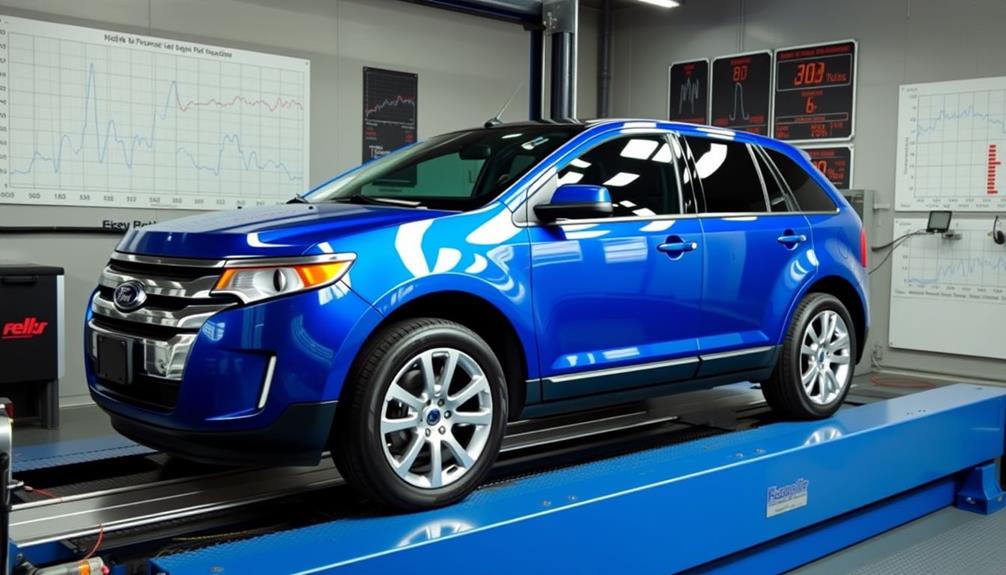
Evaluating dyno test results is essential for understanding the effectiveness of your tuning modifications on the 2011 Ford Edge Sport. After modifications, your vehicle showed a peak output of 221.7 HP at the wheels, reflecting considerable power gains over the stock performance.
Initially, during the cold run, it recorded only 185 HP, underscoring how critical it's to warm up your engine for accurate testing.
One important observation is the air to fuel ratio drop around 4200 RPMs during the initial run, which tuning corrected for smoother acceleration. These adjustments not only improve performance but also guarantee a more consistent driving experience.
Additionally, keep in mind that the estimated drivetrain loss was around 120 HP, leading to a 28% reduction from engine to wheels. This highlights how drivetrain efficiency can considerably affect your overall performance assessments.
Also, be aware that different dyno types yield varying results. For instance, Mustang dyno results typically show lower horsepower numbers than those from Dynojet, which could account for some discrepancies in reported power gains.
Types of Dyno Testing

When tuning your Ford Edge, understanding the differences between dyno types is essential.
You'll encounter Mustang dynos, which simulate real road conditions, and Dynojet, which often shows higher peak numbers.
Additionally, factors like elevation can drastically affect your results, so it's important to take into account all these elements for accurate performance assessments.
Mustang Vs. Dynojet Differences
Understanding the differences between Mustang and Dynojet dynos is essential for anyone looking to tune their Ford Edge or any other performance vehicle.
Mustang dynos typically provide lower horsepower numbers because they feature a loaded system design that simulates real road conditions. This design accounts for drivetrain losses more accurately, giving you a realistic view of your vehicle's performance.
In contrast, Dynojet dynos operate unloaded, often yielding higher and more consistent horsepower readings.
For instance, a Roush vehicle recorded 345 rwhp on a Mustang dyno, but it achieved 380 hp on a Dynojet. This discrepancy highlights the variability between the two types of dynos. While Dynojet can showcase significant potential gains, it may overshoot what you can realistically expect on the road.
Environmental factors like elevation can further complicate comparisons, with a potential 20% power loss at high altitudes.
To get meaningful results, consider performing stock dyno tests on both dyno types before modifications. This will give you valuable baseline comparisons to gauge the effectiveness of your tuning and performance upgrades.
Loaded Vs. Unloaded Testing
Precision in performance testing hinges on the choice between loaded and unloaded dyno methods. When tuning your Ford Edge, understanding these differences is critical.
Loaded dynos, such as Mustang dynos, simulate real-world driving conditions by applying resistance during testing. This creates a more accurate representation of horsepower, allowing you to gauge your vehicle's true performance potential under load. While loaded dynos typically yield lower horsepower figures, they provide insights that are more reflective of on-road driving.
In contrast, unloaded dynos, like Dynojet, operate without resistance, often resulting in higher horsepower numbers. Although these results are consistent, they may not accurately depict how your vehicle will perform in real-world scenarios. Consequently, while unloaded dynos can be useful for specific applications, they might mislead you when evaluating modifications on your Ford Edge Sport.
Ultimately, the choice between loaded and unloaded testing can greatly impact your tuning outcomes. If you're after genuine performance gains, loaded dynos are the way to go, ensuring your modifications translate well to actual driving conditions.
Understanding these testing methods will help you make informed decisions, enhancing your crossover's performance capabilities.
Impact of Elevation Factors
Elevation factors play an important role in tuning your Ford Edge, especially when it comes to dyno testing. As you venture into high altitudes, the decreased air density can lead to a significant 20% loss in horsepower for naturally aspirated engines. This makes it vital to take elevation into account when evaluating your vehicle's performance.
When testing your Ford Edge on a dyno, here are four key points to keep in mind regarding elevation:
- Dyno Type Matters: Mustang dynos simulate real-world load conditions but may show lower horsepower numbers compared to Dynojet dynos, which operate unloaded.
- Baseline Testing: Conduct stock dyno tests before modifications to establish a reliable baseline. This helps you gauge the effectiveness of any performance upgrades you make later.
- Calibration Variability: Different dyno setups can lead to variability in horsepower readings, so multiple tests are often necessary for accurate comparisons.
- Real-World Relevance: Loaded dynos like the Mustang are better for evaluating performance as they replicate actual driving conditions more closely than unloaded systems.
Understanding these factors will aid you in optimizing your Ford Edge for any elevation.
Community Feedback and Insights

The Ford Edge community has been instrumental in shaping tuning practices and sharing valuable insights. Through community feedback, members have discovered that simple modifications like a cold air intake and exhaust may yield only slight horsepower increases initially.
However, many have reported noticeable real-world performance improvements as mileage and tuning adjustments progressed. Discussions often emphasize the importance of distinguishing between engine horsepower and wheel horsepower. Users recommend conducting further dyno tests to accurately assess performance gains post-tuning.
For instance, initial dyno results for the modified Ford Edge Sport showed a peak output of only 221.7 HP at the wheels, which was considerably lower than many expected. Additionally, community members have shared their experiences of test driving other Edge Sports to compare performance, highlighting the variability in tuning outcomes.
This reinforces the need for ongoing collaboration on performance tests. By sharing dyno results and insights, you can gain a better understanding of tuning effectiveness for your Ford Edge. The collective knowledge and support within the community are invaluable for optimizing modifications and enhancing your driving experience.
Powertrain Dynamics Explained
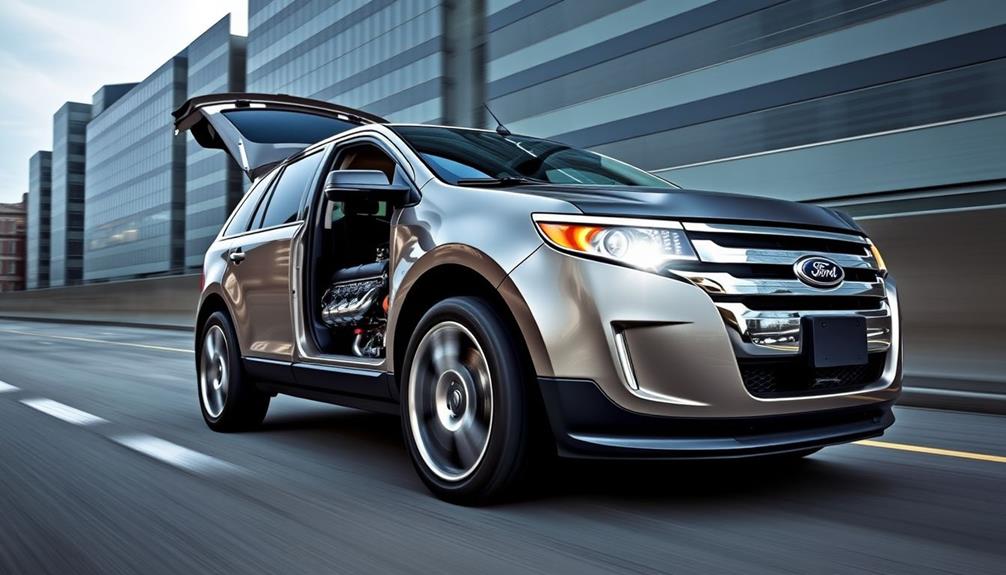
When tuning your 2011 Ford Edge, understanding drivetrain losses is essential, as they can greatly affect your car's performance.
If you opt for all-wheel drive, you'll notice about a 10% power loss compared to front-wheel drive, which impacts how power reaches the wheels.
Drivetrain Losses Explained
Drivetrain losses, often overlooked yet critical, refer to the power reduction that occurs as engine output travels to the wheels. For most vehicles, including your 2011 Ford Edge Sport, you can expect to lose around 20% of the engine's horsepower before it reaches the wheels. This means that if your engine produces 300 HP, only about 240 HP is available for driving.
Understanding drivetrain losses is essential when tuning your vehicle. Here are a few key points to evaluate:
- Power Loss: With an estimated 120 HP lost in the Ford Edge Sport, tuning efforts must account for this reduction.
- AWD vs. FWD: All-Wheel Drive vehicles typically experience about 10% more drivetrain losses due to extra components.
- Elevation Effects: High altitudes can further decrease performance, especially in naturally aspirated engines, which may see a 20% drop.
- Performance Modifications: Always factor in drivetrain losses to accurately gauge the impact of any performance upgrades you make.
AWD Vs. FWD Performance
Understanding the differences in performance between All-Wheel Drive (AWD) and Front-Wheel Drive (FWD) is key for anyone tuning a 2011 Ford Edge. AWD systems generally lose about 10% of power due to the extra components needed to send power to all four wheels. This results in a significant reduction of around 28% from engine output to wheels, especially evident in dyno results after tuning.
While AWD improves traction and stability in poor weather, it doesn't always translate to better horsepower at the wheels compared to FWD.
On the flip side, FWD configurations often allow you to harness more raw power, making them quicker in straight-line performance. However, AWD vehicles can provide a more balanced driving experience, enhancing handling and cornering capabilities.
If you modify your Edge's AWD system correctly, you can achieve impressive figures around 270-280 all-wheel horsepower (AWHP) or more.
Upcoming Dyno Testing Plans
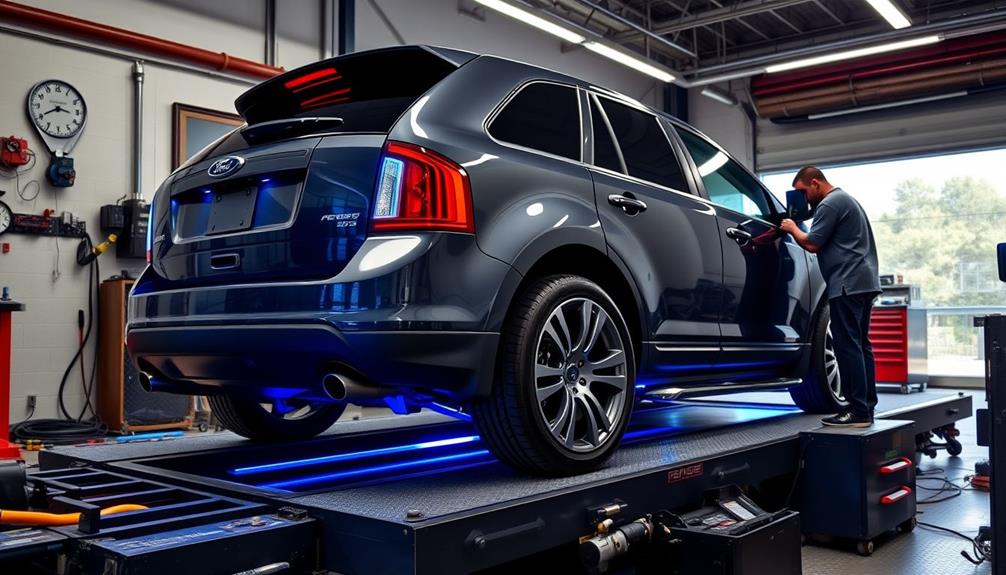
Exciting plans are underway for dyno testing on a stock 2011 Ford Edge Sport to establish baseline performance metrics.
You'll witness firsthand how your vehicle's performance can transform with the right modifications. The initial run will give you a solid benchmark before diving into enhancements like a Prozenmotorsports Cold Air Intake and a Magna Flow exhaust.
Here's what to expect from the upcoming dyno testing:
- Baseline Metrics: The first dyno run will measure your Edge's current horsepower and torque, helping you understand its starting point.
- Tuned Run: After modifications, a second run will assess the performance impacts, potentially reaching 270-280 AWHP or more.
- Dyno Comparisons: You'll learn about the differences between Mustang and Dynojet setups, emphasizing the importance of choosing the right dyno for accurate assessments.
- Community Sharing: Engage with fellow enthusiasts as you share your results, fostering discussions on performance gains achieved through tuning and modifications.
Enhancing Vehicle Technology

Enhancing vehicle technology in your 2011 Ford Edge Sport can greatly elevate your driving experience. One effective aftermarket upgrade is the Pedal Commander, which optimizes throttle response and improves overall performance without requiring extensive modifications.
This device features four driving modes—ECO, Sport, City, and Sports Plus—allowing you to tailor your driving dynamics based on your needs and conditions.
With its simple plug-and-play installation, you can skip the mechanic fees and enjoy immediate performance boosts. The Pedal Commander not only enhances acceleration but also contributes to overall vehicle efficiency, helping you achieve better fuel economy and reduced emissions.
Investing in such affordable aftermarket technologies is a smart choice for Ford owners looking to maximize control over their vehicles.
By integrating these advanced upgrades, you'll experience a driving transformation that makes your 2011 Ford Edge Sport feel more responsive and engaging.
Whether you're maneuvering through city streets or hitting the highway, these enhancements guarantee you're always in command, making your everyday drives much more enjoyable.
Industry Trends and Challenges

The automotive industry is currently maneuvering a complex landscape filled with significant challenges and evolving trends. As a Ford owner or enthusiast, you should pay attention to how these factors might influence your vehicle's performance and reliability.
1. Quality Assurance: Major brands, including Ford, face recall challenges that spotlight systemic manufacturing issues. This can affect the availability of performance parts.
The emphasis on quality assurance in software development reflects a broader trend of ensuring high standards across industries, including automotive.
2. Aging Workforce: An aging workforce in manufacturing has created skill gaps, impacting production efficiency and quality.
3. Long-term Investments: Companies are shifting focus, prioritizing long-term quality improvements over quick cost savings. This means better durability and performance for your vehicle.
4. Fuel Economy Innovations: With competition heating up, automakers are investing in technologies that enhance fuel economy, making vehicles more appealing to consumers.
Balancing innovation with user-friendly designs is vital. Excessive in-car technology can detract from the driving experience, a factor many consumers aren't thrilled about.
You can expect Ford and other manufacturers to adapt to these trends, aiming for better quality assurance and competitive performance that aligns with customer expectations. Staying informed will help you make smart choices for tuning your Ford Edge 2011 and transforming it into a true performance beast.
Frequently Asked Questions
How Much Horsepower Does a 2011 Ford Edge Limited Have?
The 2011 Ford Edge Limited has a factory-rated horsepower of 285 HP at the crank. After drivetrain losses, you'll typically see around 230-240 HP at the wheels, depending on various performance factors.
What Does Crossover Mean in Ford Edge?
A crossover blends the best of both worlds—car-like comfort and SUV versatility. In your Ford Edge, this means a spacious interior, higher driving position, and improved fuel efficiency, making it ideal for families and commuters alike.
Do Ford Edges Have Sport Mode?
Yes, Ford Edges do have a sport mode. When you engage it, you'll notice quicker acceleration and enhanced handling. It transforms your driving experience, making it more dynamic and enjoyable for spirited situations.
What Chassis Is the Ford Edge Built On?
The Ford Edge is built on the CD3 platform, which supports a weight-saving design. Its high-strength steel chassis enhances safety and structural integrity, giving you a reliable and spacious crossover for everyday driving adventures.
Conclusion
In transforming your 2011 Ford Edge into a performance beast, you're not just making modifications—you're crafting a driving experience that echoes with power and precision. As you embrace the latest tuning trends and community insights, remember: every tweak you make is a step toward revealing your vehicle's true potential. So, why settle for ordinary when extraordinary lies just a few enhancements away? Immerse yourself in the world of performance tuning and let your Edge roar like never before!
Alex is our go-to expert on performance tuning, with over a decade of experience in the automotive industry. His deep understanding of engine dynamics, exhaust systems, and performance software allows him to break down complex concepts into easy-to-follow guides. Whether you’re looking to boost horsepower or fine-tune your vehicle’s responsiveness, Alex’s insights will help you achieve peak performance.
Ford Tuning
Ford Falcon Tuning: Enhancing Power in Your Classic Muscle Car
Fuel your passion for classic muscle cars by discovering how Ford Falcon tuning can unlock incredible power and performance—uncover the secrets now!

Tuning your Ford Falcon is a game changer for enhancing power and performance. Start by optimizing your fuel-air mixture and ignition timing, which can yield a 20 to 30 kW boost. Upgrading the intake and carburetor can improve airflow, while ignition and camshaft enhancements increase responsiveness. Don't forget to upgrade your exhaust system for better power output and sound. Cooling solutions keep your engine running smoothly under stress. Joining tuning communities or working with local shops provides valuable support and insights. There's a lot more involved in transforming your Falcon, so keep exploring to reveal its full potential!
Key Takeaways
- Tuning enhances fuel-air mixtures and ignition timing, potentially boosting power by 20 to 30 kW.
- Upgrading to a performance carburetor and intake can significantly improve airflow and horsepower.
- Electronic ignition and aggressive camshaft upgrades increase engine responsiveness and torque.
- Efficient cooling solutions, like larger radiators and electric fans, maintain performance under stress.
- Engaging with tuning communities provides valuable insights and support for modifications and troubleshooting.
Importance of Tuning
Tuning your Ford Falcon is vital for releasing its full potential. When you optimize the fuel-air mixtures and ignition timing, you can improve performance and efficiency considerably. With the right modifications, you might even boost power output by 20 to 30 kW. This isn't just about raw power—it's about enhancing your overall driving experience.
ECU tuning plays an important role in this process. It can transform your throttle response and driving dynamics, making every ride more enjoyable. A J3 chip from TI Performance allows for easier DIY tuning, offering pre-programmed options that align with your specific modifications. This means you can tailor the tuning to your Falcon's unique setup.
Properly calibrated tuning not only enhances performance but also guarantees reliability, allowing your Falcon to operate efficiently under various driving conditions.
Engaging with tuning communities and utilizing online resources can provide you with valuable insights and troubleshooting support. This collaborative knowledge can help you maximize the benefits of your modifications, guaranteeing your Ford Falcon stands out on the road.
Embrace tuning, and you'll reveal the true potential of your classic muscle car.
Engine Upgrades Overview
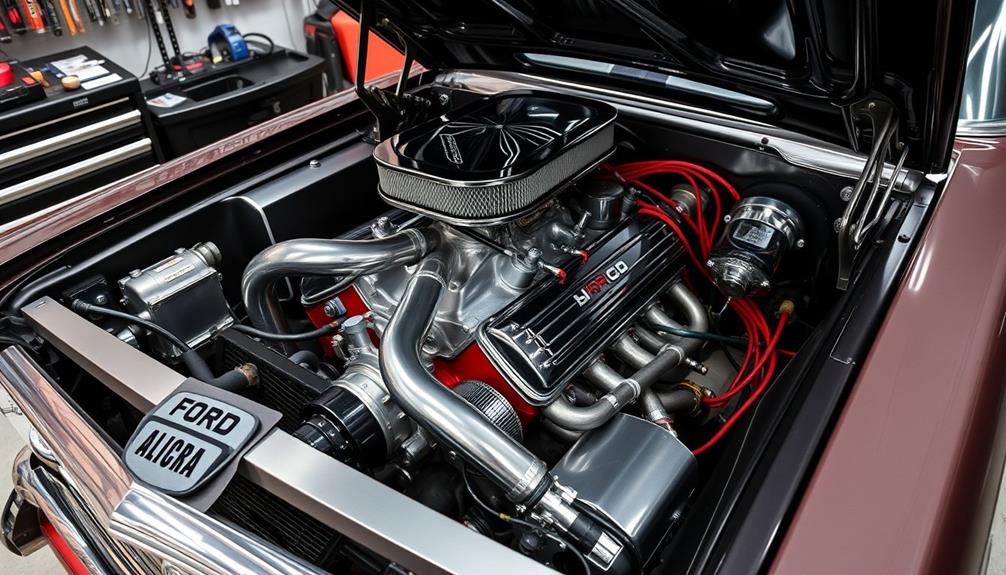
When you think about engine upgrades for your Ford Falcon, consider the impact of intake and carburetor options on airflow and horsepower.
You can also boost performance with ignition and camshaft improvements that enhance your engine's responsiveness.
Don't forget about cooling solutions and upgrades to keep everything running smoothly as you push for more power.
Intake and Carburetor Options
To maximize your Ford Falcon's performance, exploring intake and carburetor options is vital. Upgrading to a 4V intake paired with a ~400 cfm carburetor can greatly enhance throttle response and fuel efficiency. If you're looking for a boost, consider installing a Holley carburetor, such as the 390 or 465 cfm models, to improve airflow and overall engine performance. Dual port intakes like the Pffenhauser are also recommended for maximizing airflow in modified engines.
Here's a quick comparison of some popular intake and carburetor options:
| Intake Type | Carburetor Options | Performance Benefits |
|---|---|---|
| 4V Intake | ~400 cfm | Enhanced throttle response, fuel efficiency |
| Holley 390 cfm | Dual port | Increased airflow and power |
| Holley 465 cfm | Electronic Fuel Injection | Improved power delivery and efficiency |
| Pffenhauser | 390 or 465 cfm | Maximized airflow for modified engines |
| Traditional Carb | Standard 2V | Basic performance upgrade |
Proper tuning of your carburetor is essential; even minor adjustments can lead to considerable improvements in horsepower and drivability.
Ignition and Camshaft Improvements
Significant improvements in your Ford Falcon's performance can be achieved through ignition and camshaft upgrades. Upgrading from a points system to an electronic ignition can provide more consistent spark delivery, boosting engine reliability and performance. This upgrade guarantees that your engine fires efficiently, maximizing power output.
Next, consider installing a slightly more aggressive camshaft, like the Comp Cams 260 or 268. These camshafts improve horsepower and torque, particularly in the 3000-7000 RPM range, which is ideal for performance builds.
Pairing your new camshaft with hydraulic roller lifters can further enhance power delivery while reducing friction, leading to better engine efficiency.
Adding roller rockers is another excellent option. They increase valve lift without needing to adjust pushrod lengths, enhancing valve performance and improving your engine's overall output.
However, it's essential to verify that your new valve springs are compatible with the cam upgrades. This will prevent valve float and maintain peak performance across varying RPMs.
Cooling Solutions and Upgrades
After enhancing your ignition and camshaft setup, it's time to focus on cooling solutions that can further elevate your Ford Falcon's performance. Upgrading to an electric fan from models like the older Taurus or Windstar can greatly improve your cooling system's efficiency, especially under high-stress conditions. This change guarantees your engine stays cool when you're pushing it to its limits.
Installing a larger radiator with better airflow capabilities is another vital step. It helps maintain ideal engine temperatures, particularly when paired with other performance upgrades that generate extra heat.
You might also want to take into account high-performance thermostat options that open at lower temperatures, which keeps your engine running in a safer and more efficient range.
Adding a coolant overflow tank is a smart move too, as it can prevent overheating issues by managing excess coolant and maintaining proper pressure.
Finally, don't forget that regular maintenance of your cooling system is important. Flushing the radiator and checking hoses will help prevent overheating and guarantee the longevity of your engine's performance enhancements.
With these upgrades, your Ford Falcon will be ready to hit the road with confidence.
Performance Enhancements
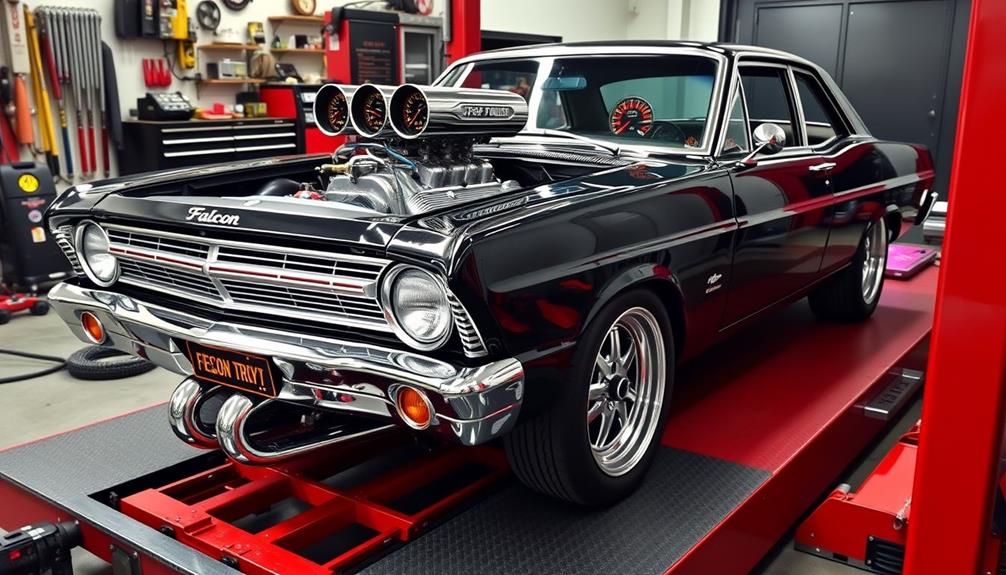
When you think about performance enhancements for your Ford Falcon, upgrading the suspension is key for sharper handling.
Don't overlook the importance of an efficient exhaust system; it can boost both power and sound without breaking the bank.
Suspension Upgrades Importance
Enhancing your Ford Falcon's suspension is essential for achieving ideal performance on the road. Suspension upgrades can greatly improve your vehicle's handling and responsiveness, giving you a more enjoyable driving experience.
By lowering the stock suspension, you can reduce body roll and lower the center of gravity, which enhances stability during turns.
If you're dealing with worn-out shocks, replacing them with high-quality aftermarket options can make a noticeable difference in ride comfort and control.
Consider installing coilovers or lowering springs, as these upgrades start around $250 and offer a cost-effective way to enhance your Falcon's performance.
Another excellent option is a double wishbone front suspension upgrade. This setup considerably improves turn-in feel, allowing for sharper cornering and a more engaging driving experience.
With these suspension enhancements, you'll not only boost your Falcon's performance but also enjoy a smoother ride on the road.
Exhaust System Efficiency
Upgrading your Ford Falcon's exhaust system can make a noticeable impact on performance, just like improving the suspension does. By enhancing your exhaust system, you can reduce back pressure, allowing for better airflow that boosts both power output and sound.
Here are three key enhancements to contemplate:
- Cat-Back Exhaust System: Starting around $250, this upgrade greatly improves airflow, enhancing engine power and providing a more aggressive exhaust note.
- Headers or Extractors: Installing headers can increase horsepower by 10-20%, depending on your engine setup. This improvement in exhaust flow really makes a difference.
- Custom Fabrication: If your setup requires it, custom exhaust fabrication guarantees ideal routing and clearance, maximizing efficiency.
A well-designed exhaust system not only amplifies your Falcon's power output but also enhances throttle response and fuel efficiency under load.
Each modification contributes to a more exhilarating driving experience, making your classic muscle car feel even more powerful.
Differential Gear Optimization
The Ford Falcon's performance can greatly benefit from differential gear optimization, as the right gearing can transform your driving experience. Upgrading to a higher gear ratio, like 3.73:1 or 4.11:1, can considerably enhance acceleration and responsiveness. Many factory Falcons come equipped with limited-slip differentials (LSDs) that might not offer the traction you need. By upgrading to a true track LSD, you'll notice improved handling and cornering.
If you're into racing or drifting, consider installing a spool or welding the differential. This can maximize traction but may compromise street drivability due to increased tire scrubbing. When replacing your differential, don't forget to upgrade the bushes; this reduces unwanted movement, enhancing power transfer and overall performance. Regularly maintaining your differential fluid is also essential, as fresh fluid reduces friction and promotes smoother operation.
Here's a quick comparison of differential upgrades:
| Upgrade Type | Benefits |
|---|---|
| Higher Gear Ratio | Improved acceleration |
| True Track LSD | Enhanced traction |
| Spool/Welded Diff. | Maximum traction for racing |
| Differential Bushes | Better handling |
| Fresh Fluid | Smoother operation |
Fuel Efficiency Improvements

Improving fuel efficiency in your Ford Falcon can lead to significant savings and a better driving experience. By tuning your classic muscle car, you can enhance both performance and fuel economy. Here are three effective ways to achieve this:
- Upgrade the Carburetor: Switching to a more efficient carburetor, like the Holley 2300, can boost airflow, helping you improve fuel efficiency while maintaining performance.
- Install a Dual Port Intake System: Utilizing a system such as the Pffenhauser can optimize air intake, resulting in better combustion efficiency and fuel economy.
- Dyno Tune: Optimizing your air-fuel mixture and ignition timing through dyno tuning can yield significant improvements, often reported at up to 20% better mileage.
Additionally, consider re-gearing your differential to a higher ratio like 3.55:1. This change enhances acceleration while keeping RPMs lower during cruising, further contributing to improved fuel efficiency.
Don't forget about installing an electric fan to reduce engine load and boost cooling efficiency, which also enhances overall engine performance.
With these adjustments, you'll enjoy a balance of power and fuel efficiency in your Falcon.
Cost Considerations

When considering modifications for your Ford Falcon, it's essential to weigh the costs against the potential benefits. As a performance owner and enthusiast, you want to guarantee that your investments truly enhance your vehicle's capabilities. Here's a quick overview of some common costs associated with tuning your Falcon:
| Modification | Cost Range |
|---|---|
| Manual Transmission Conversion | $1,500 – $2,000 |
| Cat-Back Exhaust System | $250 – $600 |
| ECU Tuning | Varies |
| Differential Upgrade | Varies |
These cost considerations can greatly impact your budget, but they also promise improvements in performance and driving enjoyment. For instance, upgrading your exhaust system can not only enhance sound but also boost horsepower. Meanwhile, a well-calibrated ECU tune might yield a power gain of 20 to 30 kW.
Investing in suspension upgrades can improve handling, while enhancing traction through a differential upgrade guarantees you're getting the most out of your Falcon's power. Ultimately, the right choices can lead to a rewarding driving experience and potentially increase your vehicle's resale value, making these modifications worthwhile.
Community Insights

How can you tap into the wealth of knowledge within the Ford Falcon community? By connecting with fellow enthusiasts, you'll find invaluable insights into performance enhancements and tuning experiences. The community thrives on sharing tips, tricks, and advice, making it easier for you to navigate your tuning journey.
Here are three ways to leverage community support:
- Join Online Forums: Websites like fordsix.com are treasure troves of information. You can ask questions, read about others' experiences, and discover the best modifications for your Falcon.
- Participate in Social Media Groups: Dedicated Facebook groups are fantastic for real-time advice. Members often share their successes and failures, helping you avoid common pitfalls.
- Connect Locally: Seek out local tuning shops that specialize in Falcons. Many of these shops have strong ties to the community and can provide expert guidance tailored to your specific needs.
Technical Support Resources
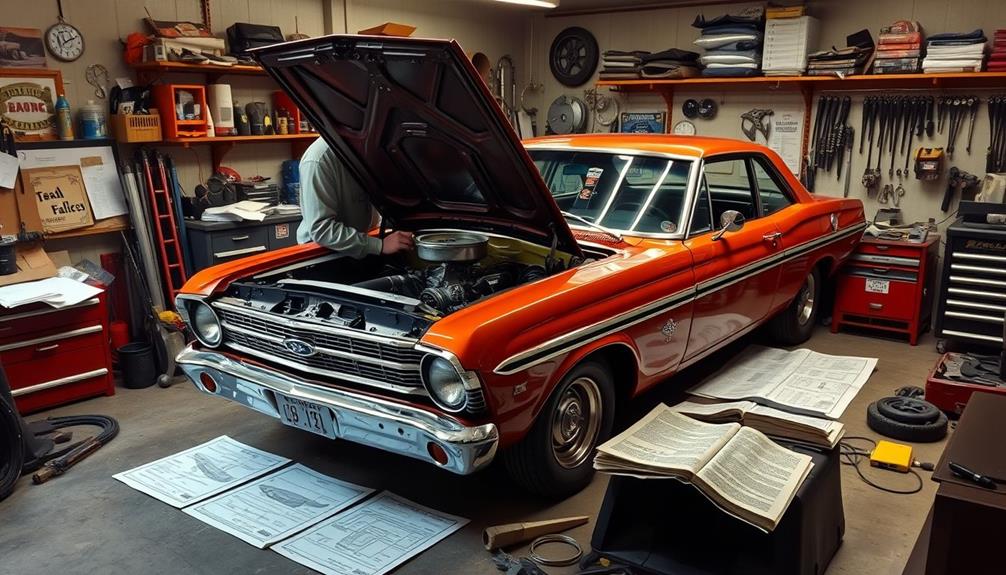
Tapping into the right technical support resources can make all the difference in your Ford Falcon tuning journey. Online forums like fordsix.com and dedicated Falcon communities are invaluable for gaining advice and troubleshooting tips.
You'll find shared experiences that can guide you through various tuning and performance enhancements, making the process smoother.
If you're looking for professional assistance, local tuning shops can provide the expertise needed for advanced modifications. They guarantee that your Falcon's performance upgrades are installed and calibrated correctly, maximizing their effectiveness.
For DIY enthusiasts, online tutorials and videos offer step-by-step guidance on tuning aspects like ECU adjustments, assuring you tackle modifications confidently.
Don't underestimate the power of community support. Engaging with fellow enthusiasts through forums allows you to seek help for specific tuning issues, creating a collaborative environment that's beneficial for everyone.
Continuous interaction within these communities keeps you updated on the latest upgrades and innovative tuning techniques. By utilizing these technical support resources, you'll enhance not just your Falcon's performance but also your enjoyment of the tuning journey.
Dyno Tuning Benefits
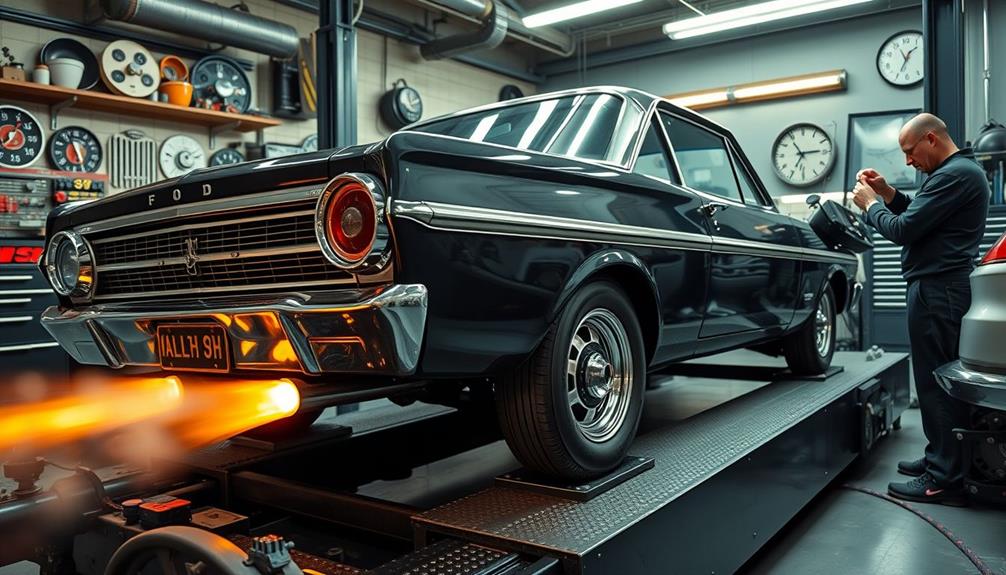
Releasing your Ford Falcon's true potential often hinges on the advantages of dyno tuning. This process allows for precise adjustments to fuel delivery and ignition timing, leading to significant increases in horsepower and overall performance.
Many users have reported impressive gains of 20-30 HP, with some achieving up to 58 rwhp on their builds. By evaluating and fine-tuning the air-fuel ratio, you can dramatically enhance your engine's responsiveness and efficiency.
Here are three key benefits of dyno tuning:
- Enhanced Performance: Real-time adjustments during dyno sessions provide immediate feedback, ensuring your engine runs effectively under various driving conditions.
- Increased HP: With proper tuning, you can achieve substantial horsepower gains, transforming your classic muscle car into a more powerful machine.
- Cost-Effective Investment: Although professional dyno tuning may cost around $375, the performance enhancements and efficiency gains often justify the expense.
Popular Modifications for Falcons
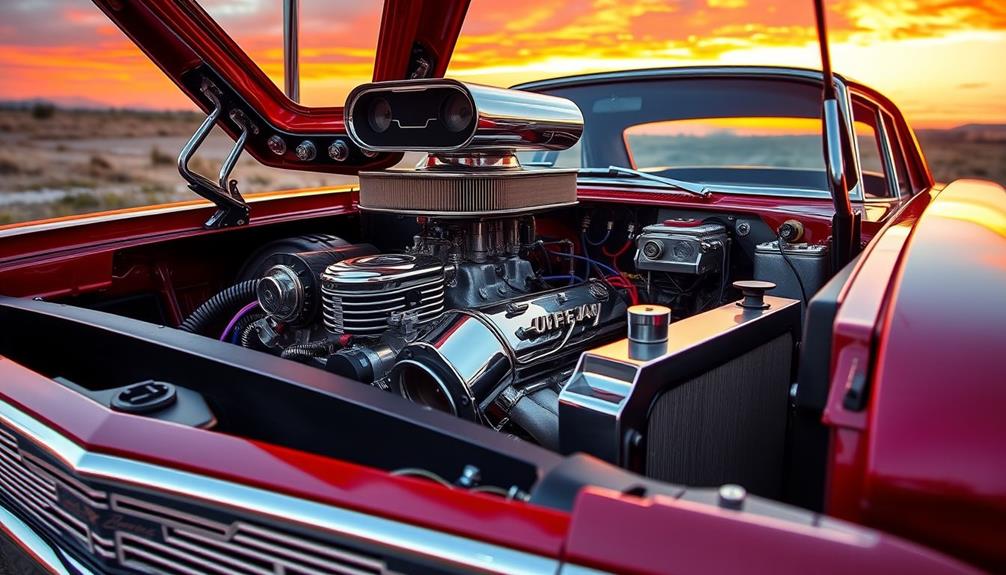
Ford Falcons have become a canvas for automotive enthusiasts enthusiastic to release their creativity and enhance performance. With strong aftermarket support, you can easily engage in popular modifications that boost both power and handling.
Here's a quick overview of some sought-after upgrades:
| Modification Type | Description | Estimated Cost |
|---|---|---|
| Suspension Upgrades | Upgrade to double wishbone for improved handling. | $800 – $1,200 |
| Exhaust Systems | Install extractors or cat-back for better sound and power. | $600 |
| LSD Options | Choose a spool or true track LSD for better traction. | $1,000 – $1,500 |
| Manual Transmission | Convert to a manual for enhanced driver engagement. | Varies |
These modifications can transform your Falcon into a true performer. By enhancing the suspension, you'll notice improved responsiveness on the road. Upgrading your exhaust systems not only releases more power but also gives your car a more aggressive sound. Finally, improving your LSD setup will guarantee better traction, especially during spirited driving. With these changes, you'll elevate your classic muscle car experience to a whole new level.
Frequently Asked Questions
How to Add Horsepower to a Classic Car?
To add horsepower to your classic car, upgrade the carburetor, install a performance intake manifold, choose a suitable camshaft, incorporate exhaust headers, and regularly dyno tune for peak performance. You'll feel the difference!
Are Ford Falcons Powerful?
You might say Ford Falcons pack a punch! Their robust design and performance capabilities guarantee you'll experience thrilling drives. With some enhancements, you'll discover just how powerful these classic machines can truly be.
Is the Ford Falcon a Muscle Car?
You'd find the Ford Falcon does embody muscle car traits, especially in its performance variants. With powerful engines and a lightweight design, it competes well within that category, appealing to enthusiasts seeking classic muscle experiences.
How Much Horsepower Did the Ford Falcon Have?
The Ford Falcon's horsepower varied from about 85 to over 300, depending on the model and engine. You'd find early models with six-cylinder engines and later versions boasting powerful V8s for enhanced performance.
Conclusion
To sum up, tuning your Ford Falcon can greatly enhance its performance and efficiency, giving you that exhilarating driving experience you crave. For instance, consider a Falcon owner who added a high-performance intake and exhaust system, resulting in a 20% increase in horsepower and improved fuel economy. By investing in the right upgrades and tuning practices, you'll not only elevate your classic muscle car's power but also enjoy the benefits of better handling and responsiveness on the road.
Alex is our go-to expert on performance tuning, with over a decade of experience in the automotive industry. His deep understanding of engine dynamics, exhaust systems, and performance software allows him to break down complex concepts into easy-to-follow guides. Whether you’re looking to boost horsepower or fine-tune your vehicle’s responsiveness, Alex’s insights will help you achieve peak performance.
Ford Tuning
Ford Falcon Tuning: Enhancing Power in Your Classic Muscle Car
You’ll discover essential tuning tips for your Ford Falcon that can unleash its hidden power, but what upgrades should you prioritize first?

Tuning your Ford Falcon is key to revealing its true performance potential. Start with engine modifications like a multi-barrel carburetor and high-flow headers to boost horsepower. Upgrading your exhaust system not only enhances power but also transforms the sound. Don't overlook suspension tweaks, as coilovers and sway bars improve handling during aggressive driving. Consider adding turbocharging for significant power gains. You can expect to invest between $1,000 and $2,000, but the results are worth it. Curious about specific upgrades? There's so much more to explore to maximize your Falcon's performance.
Key Takeaways
- Upgrading the exhaust system and installing performance headers can significantly increase horsepower and enhance sound on your Ford Falcon.
- Tuning the carburetor and intake manifold improves airflow and fuel efficiency, boosting overall engine performance.
- Suspension upgrades like coilovers and sway bars enhance handling, cornering stability, and driving confidence.
- Turbocharging with custom headers can elevate power output beyond 300 HP, transforming your classic muscle car's performance.
- Proper tuning and regular performance testing are essential for achieving optimal results and maximizing the benefits of modifications.
Overview of Ford Falcon Tuning
When it comes to enhancing your Ford Falcon, tuning offers a wealth of opportunities to elevate performance and driving pleasure.
For performance owners, upgrading components like the exhaust system is a game-changer. Installing extractors and cat-back systems not only boosts horsepower but also transforms the sound, providing that exhilarating growl you crave. Typically, you can expect to spend around $600 for extensive exhaust enhancements.
Another significant area to take into account is the suspension. Lowering your Falcon's stock suspension and upgrading to coilovers can drastically improve handling and responsiveness. You'll notice better turn-in feel, giving you more confidence on curvy roads.
If you're serious about performance driving, you might also want to explore upgrades like a true track LSD or a spool for improved traction.
Lastly, if your Falcon has a manual transmission, converting to one can enhance driver engagement, making every shift a thrilling experience. Plus, it often increases your car's resale value, which is a smart move for any performance enthusiast.
With these tuning options, your Ford Falcon won't just look great but also deliver an unforgettable driving experience.
Key Engine Modifications
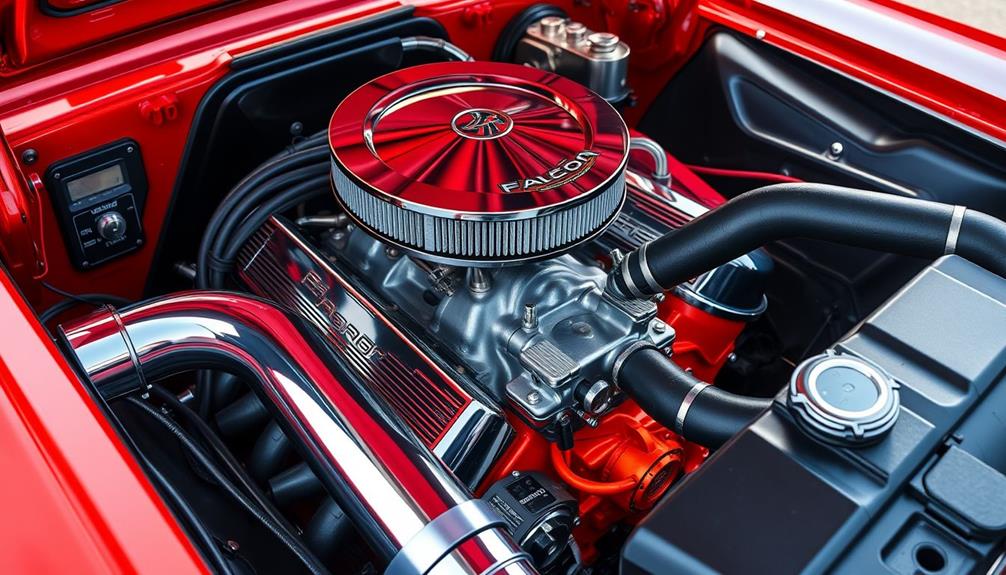
To truly release the potential of your Ford Falcon, focusing on key engine modifications is a must. Upgrading to a multi-barrel carburetor, like the Holley 5200, can greatly improve airflow and responsiveness. A performance intake manifold enhances power delivery by maximizing air and fuel mixture efficiency, essential for better throttle response.
Here's a quick overview of effective modifications:
| Modification | Benefits |
|---|---|
| Multi-barrel carburetor | Increases airflow and engine responsiveness |
| Performance intake manifold | Improves throttle response and efficiency |
| Camshaft upgrade (Comp Cams) | Optimizes power output for your RPM range |
| High-flow headers | Reduces backpressure, boosts horsepower |
Replacing the stock exhaust with high-flow headers and a cat-back system can lead to a more aggressive sound profile and improved horsepower. Additionally, a multi-spark ignition system, such as those from MSD, enhances combustion efficiency, ensuring your car runs smoothly and delivers consistent performance. These modifications work together to transform your classic muscle car into a powerhouse, delivering the performance you crave.
Intake and Exhaust Upgrades
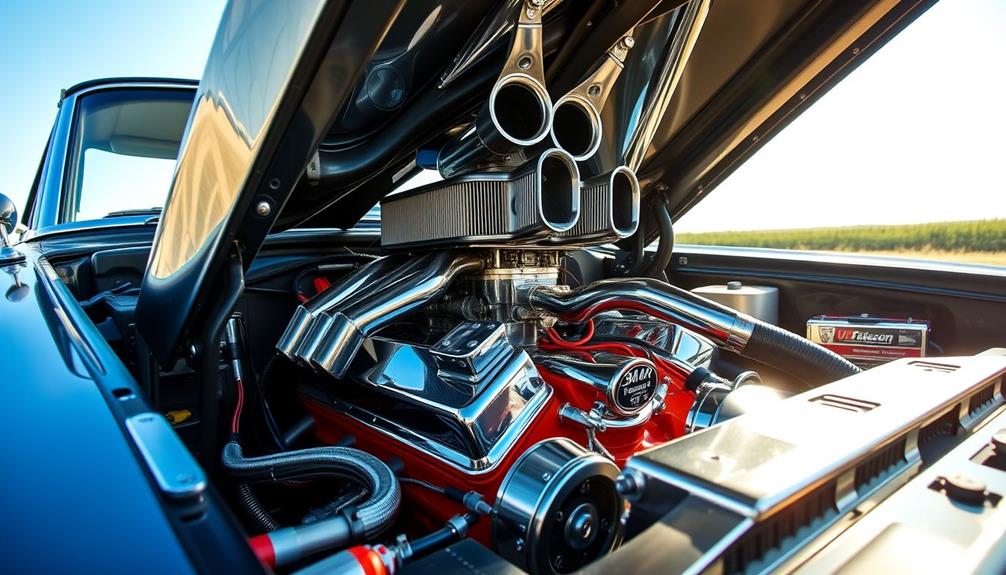
Upgrading your Ford Falcon's intake and exhaust systems can release significant performance gains. One of the best ways to start is by swapping out your stock intake manifold for a high-performance option like the Offenhauser 3x1bbl. This upgrade enhances airflow and boosts overall engine performance, giving your Falcon the power it deserves.
Next, consider installing headers. These extractors reduce exhaust restrictions, which leads to improved horsepower and a more aggressive exhaust note. While you can typically expect to spend around $600 for quality headers, the performance benefits are well worth the investment.
Don't forget about your exhaust system. Many stock setups are overly restrictive, so opting for a budget-friendly cat-back exhaust upgrade, costing about $250, can transform both your vehicle's performance and sound.
However, proper tuning is essential. Mismatched components in your intake and exhaust systems can lead to disappointing results. Confirm all parts are compatible to maximize horsepower and improve throttle response.
With these upgrades, you'll take your Ford Falcon to a whole new level of performance.
Ignition System Enhancements

Upgrading your Ford Falcon's ignition system can make a noticeable difference in performance.
Switching from points to an electronic ignition not only boosts reliability but also simplifies maintenance.
Electronic Ignition Upgrade
An electronic ignition upgrade can markedly transform your Ford Falcon's performance and reliability. By swapping out the old points system for an electronic ignition system, like those from Pertronix or Duraspark, you'll enjoy improved ignition reliability that translates to better throttle response.
You'll notice your engine runs more smoothly and efficiently, thanks to the consistent spark timing these systems provide.
Installation is typically straightforward, allowing you to replace existing components without extensive modifications. This means you can enhance your Falcon's performance without a hassle.
Many performance owners report gains of up to 10% in horsepower after retrofitting an electronic ignition system, optimizing combustion timing for a noticeable boost in power.
Moreover, with the benefits of an electronic ignition system, you'll achieve better fuel efficiency, making every drive more enjoyable.
So, if you're looking to enhance your classic muscle car's capabilities, investing in an electronic ignition upgrade is a smart move. You'll be rewarded with a more responsive engine, increased reliability, and an overall better driving experience.
Upgrade today and feel the difference in your Ford Falcon's performance!
Multi-Spark Systems Benefits
Experience a new level of performance with multi-spark ignition systems, which offer significant benefits for your Ford Falcon. These systems, like those from MSD, deliver multiple sparks during each combustion event, ensuring a more complete burn of the air-fuel mixture. This enhanced combustion leads to better throttle response and power delivery, making it ideal for performance driving.
Additionally, just as a Gold IRA can provide a hedge against market fluctuations, enhancing your ignition system can safeguard your vehicle's performance in varying driving conditions.
When you upgrade to a multi-spark ignition, you can expect a noticeable hp increase. Many users have reported improvements in horsepower and torque, transforming their classic muscle cars into more powerful machines.
Plus, by fine-tuning combustion, these systems can help improve fuel economy and reduce unburned fuel emissions.
Another key advantage is the increased ignition reliability, especially for modified engines that demand higher performance components. With a multi-spark ignition system, you'll gain the confidence that your engine is firing efficiently, even under demanding conditions.
Timing Adjustment Techniques
Adjusting your Ford Falcon's ignition timing can often lead to noticeable improvements in engine performance. By fine-tuning the timing, you can enhance throttle response and even increase horsepower.
Here are three effective timing adjustment techniques to take into account:
- Use a Timing Light: This handy tool lets you measure your current ignition timing against factory specifications. Simply point the timing light at the timing marks and adjust the distributor until you reach the desired timing.
- Aim for Ideal Base Timing: For most Ford Falcon engines, setting your base timing between 10-14 degrees BTDC (Before Top Dead Center) can yield the best results. Keep in mind this might vary based on your specific modifications and the fuel you're using.
- Upgrade to Electronic Ignition: Switching from a points system to an electronic ignition, like Pertronix or Duraspark, can greatly improve spark consistency. This leads to better combustion efficiency and overall engine performance.
Regularly check and adjust your ignition timing, especially after any modifications. Doing so guarantees your engine runs smoothly while maximizing power output!
Suspension and Drivetrain Adjustments
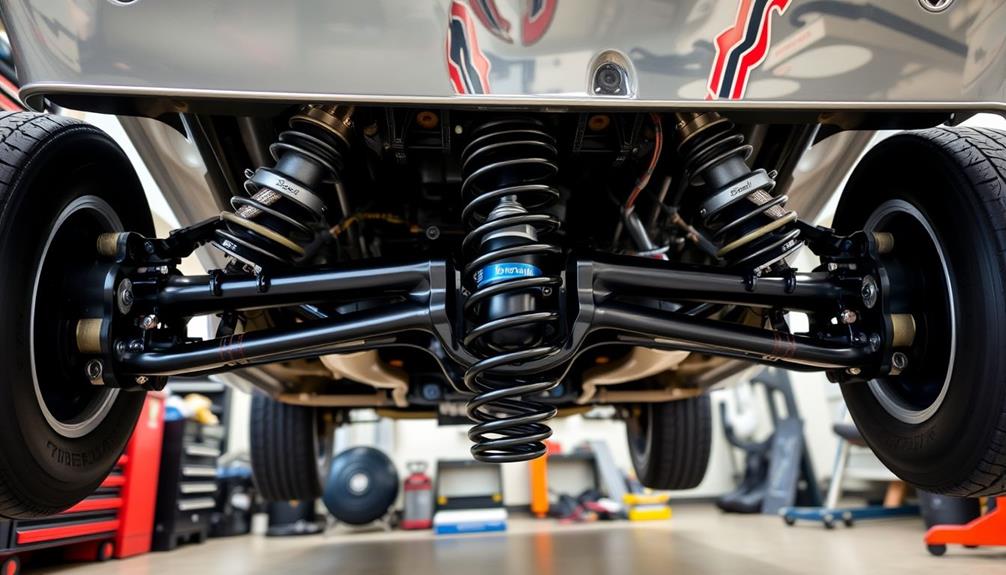
Suspension and drivetrain adjustments play an essential role in enhancing the performance of your Ford Falcon. Upgrading to a double wishbone front suspension can dramatically improve handling and responsiveness, giving you a sharper turn-in feel during cornering.
Lowering the stock suspension reduces body roll, which increases stability and creates a more engaging driving experience, especially when you're pushing it on winding roads or at the track.
If your Falcon's shocks are worn out, replacing them with high-quality options can restore ride quality and handling capabilities, ensuring you get the most out of your suspension.
Additionally, focusing on your drivetrain can yield significant benefits; for instance, upgrading the differential to a true track LSD or installing a spool can greatly enhance traction and overall driving dynamics.
While you're at it, consider installing extractors or a cat-back exhaust system to improve exhaust flow and power output. This upgrade not only boosts performance but also enhances your Falcon's sound, making every drive more thrilling.
Turbocharging and Forced Induction

When considering turbocharging your Ford Falcon, you'll want to focus on turbo selection and custom header requirements to maximize performance.
A well-chosen turbo can greatly boost your engine's power output, allowing you to compete with V8s.
With the right setup, you can release the full potential of your inline six-cylinder engine.
Turbo Selection Guidelines
Selecting the right turbocharger for your Ford Falcon can drastically enhance its performance, offering a thrilling boost in power. When you're on the hunt for a turbo, consider these guidelines to make the best choice for your classic muscle car:
- Cost-Effectiveness: A T4 turbo from a junkyard can be a budget-friendly option that considerably increases power potential. You can enjoy enhanced performance without breaking the bank.
- Rebuilding Options: If you're looking to save money, consider rebuilding a used turbo. This can maintain your budget while still providing a performance upgrade that rivals V8s, especially when paired with the right modifications.
- Compatibility: Always assess your entire engine setup before selecting a turbo. Verify that the turbo matches your headers and other supporting modifications for ideal exhaust flow and maximum power gains.
Custom Header Requirements
After choosing the right turbocharger for your Ford Falcon, the next step is making sure your exhaust system can handle the increased demands of forced induction. Custom headers are often necessary to optimize exhaust flow and support higher power output.
When designing your custom headers, consider the turbo's location and verify there's adequate clearance to prevent heat damage to nearby components.
Using tubular headers can greatly enhance exhaust scavenging, which boosts turbo performance and overall engine efficiency. This improvement can lead to considerable power gains, making your inline-six Falcon competitive with V8s, especially when properly modified.
If you're working with a used turbo, rebuilding it can be a cost-effective approach, but remember that pairing it with the right custom headers is essential for achieving the desired power levels without sacrificing reliability.
Ultimately, a well-designed custom header setup can help you reach upwards of 300 HP in your turbocharged Ford Falcon. By prioritizing these custom headers, you're setting yourself up for an impressive performance upgrade that takes full advantage of turbocharging.
Performance Boost Potential
Turbocharging your Ford Falcon can release significant power potential, transforming it into a performance powerhouse. By adding a T4 turbo, you could see power output gains exceeding 300 HP, making it an exciting option for those craving serious performance enhancements.
With proper tuning and supporting modifications, your classic muscle car can rival even V8 engines.
Here are three key advantages of turbocharging your Falcon:
- Substantial Performance Gains: Turbocharging allows you to achieve high horsepower levels that can dramatically improve acceleration and overall driving experience.
- Cost-Effective Upgrades: Rebuilding a used turbo is a budget-friendly way to boost power without breaking the bank, guaranteeing you get great performance without excessive expenditure.
- Optimized Exhaust Flow: Installing custom headers is often necessary to maximize exhaust flow, which enhances performance and guarantees the turbo operates efficiently.
Cost Considerations for Upgrades

When it comes to upgrading your Ford Falcon, understanding the cost considerations is vital for making informed decisions. Budgeting for performance upgrades typically ranges from $1,000 to $2,000, depending on the modifications and parts you choose.
For example, installing an upgraded exhaust system can set you back around $600, but it notably enhances both power output and driving experience.
If you're thinking about converting to a manual transmission, be prepared for an investment between $1,500 to $2,000. This can potentially increase your car's resale value while making driving more enjoyable.
Another popular upgrade is ECU tuning, which can yield impressive power gains of 20 to 30 kW. However, this may require additional costs for supporting modifications like exhaust systems and intakes to truly optimize performance.
When considering these upgrades, it's important to evaluate the cost-effectiveness of each part versus the potential horsepower gains. Some modifications mightn't deliver considerable improvements relative to their expense, so spend your budget wisely to maximize performance without breaking the bank.
Community Support and Resources

Tapping into the vibrant community of Ford Falcon enthusiasts can greatly enhance your tuning journey. This community dedicated to Ford is filled with passionate performance owners and enthusiasts who are keen to share their knowledge and experiences.
By engaging with them, you'll find a treasure trove of resources that can guide you through tuning processes and performance enhancements.
Here are three ways to leverage this support:
- Online Forums: These platforms are gold mines for shared experiences. You can ask questions, troubleshoot issues, and gather insights from fellow Falcon owners who've tackled similar challenges.
- DIY Tutorials and Videos: Many community members create step-by-step guides that walk you through various tuning processes. These resources simplify complex modifications, making it easier for you to enhance your Falcon's performance.
- Local Tuning Shops: Often, these shops collaborate with the community to offer specialized services. They can provide expert advice on advanced modifications tailored specifically for your Falcon.
Engaging with this community keeps you informed about the latest upgrades, ensuring your tuning modifications remain effective and reliable. Engaging with this community keeps you informed about the latest upgrades, ensuring your tuning modifications remain effective and reliable. You’ll also gain valuable insights from fellow enthusiasts who share their experiences and recommendations, helping you make more informed decisions. Additionally, staying connected allows you to discover expert Mazda 3 chip tuning tips, which can optimize performance and maximize the potential of your vehicle for an unparalleled driving experience.
Performance Testing and Results

Testing the performance of your modified Ford Falcon is essential to understanding the real impact of your tuning efforts. You'll want to track the power gains from various modifications, as even budget-friendly upgrades can make a considerable difference. For instance, ECU tuning can yield an increase of 20 to 30 kW when paired with the right enhancements.
Consider the following table for a quick overview of performance testing results:
| Modification Type | Average Power Gain |
|---|---|
| ECU Tuning | 20-30 kW |
| Cat-Back Exhaust | 10-15 kW |
| Manual Transmission | 5-10 kW |
Proper tuning calibration is vital, as improper adjustments can lead to poor engine performance. Community feedback shows that advanced tuning options, like PCM Tech software for BA to FGX Falcons, reveal features such as rolling anti-lag and launch control, greatly enhancing track performance. Remember, the more you test and refine your setup, the better your Falcon will perform on the road or track.
Frequently Asked Questions
How to Add Horsepower to a Classic Car?
To add horsepower to your classic car, consider upgrading the carburetor, installing a performance intake manifold, choosing an aggressive camshaft, implementing a quality exhaust system, and dyno tuning your engine for peak performance.
Are Ford Falcons Powerful?
Yes, Ford Falcons are powerful, especially models like the EF XR6. With the right modifications and tuning, you can boost their horsepower considerably, making them competitive and thrilling to drive on any road.
Is the Ford Falcon a Muscle Car?
You might consider the Ford Falcon a muscle car, especially the performance models. With its V8 engine and lightweight design, it offers impressive power and agility, making it a favorite among enthusiasts seeking thrilling driving experiences.
How Much Horsepower Did the Ford Falcon Have?
The Ford Falcon's horsepower varied by year and engine. Initially, it had 90 HP, increasing to 101 HP by 1963. By 1967, models reached up to 250 HP, showcasing impressive advancements in power over time.
Conclusion
In enhancing your Ford Falcon, you're not just boosting power; you're releasing potential, igniting passion, and transforming a classic into a powerhouse. Whether you're tweaking the intake, fine-tuning the exhaust, or supercharging for speed, every modification brings you closer to your dream ride. So immerse yourself in the world of tuning, embrace the journey, and enjoy the thrill of the drive. Your Falcon's best days are ahead—let's make them unforgettable!
Alex is our go-to expert on performance tuning, with over a decade of experience in the automotive industry. His deep understanding of engine dynamics, exhaust systems, and performance software allows him to break down complex concepts into easy-to-follow guides. Whether you’re looking to boost horsepower or fine-tune your vehicle’s responsiveness, Alex’s insights will help you achieve peak performance.
-

 Hybrid Tuning3 months ago
Hybrid Tuning3 months agoHonda Civic Hybrid Tuning: Unlocking Maximum Efficiency and Performance
-

 Hybrid Tuning3 months ago
Hybrid Tuning3 months agoPorsche Cayenne E-Hybrid Tuning: Unleashing the Beast Within the Luxury SUV
-

 Audi Tuning3 months ago
Audi Tuning3 months agoChip Tuning Audi: How to Unlock Extra Power Instantly
-

 Automotive DIY and Professional Guides3 months ago
Automotive DIY and Professional Guides3 months agoWhen Is Car Tuning Required? Signs It’s Time for an Upgrade
-

 Audi Tuning3 months ago
Audi Tuning3 months agoAudi A3 Tuning: Elevate Your Compact Car’s Performance
-

 Hybrid Tuning3 months ago
Hybrid Tuning3 months agoInfiniti Q50 Hybrid Chip Tuning: Enhance Performance With Precision Tuning
-

 Hybrid Tuning3 months ago
Hybrid Tuning3 months agoNissan Altima Hybrid Tuning: Upgrade Your Sedan for Maximum Efficiency
-

 Hybrid Tuning3 months ago
Hybrid Tuning3 months agoCube Reaction Hybrid Tuning: Get the Most Out of Your Electric Bike















